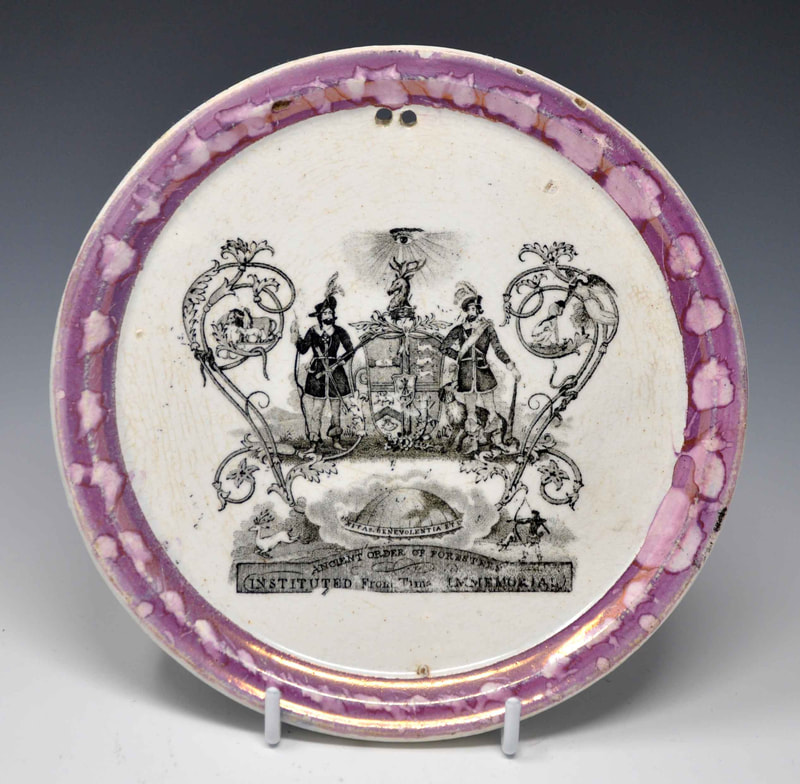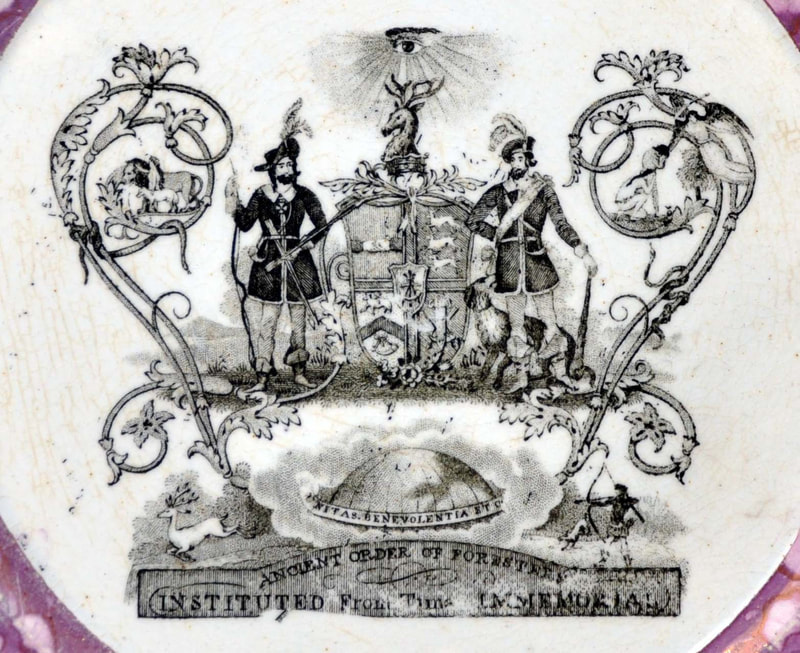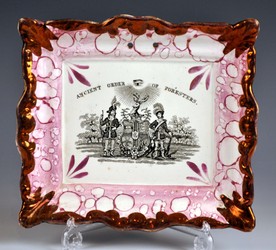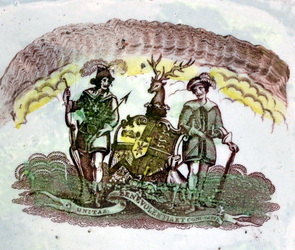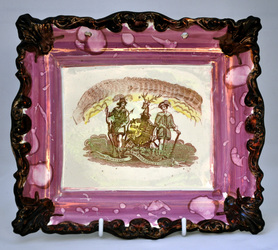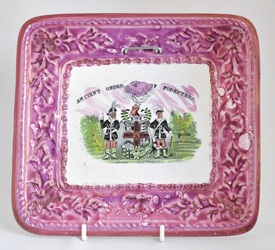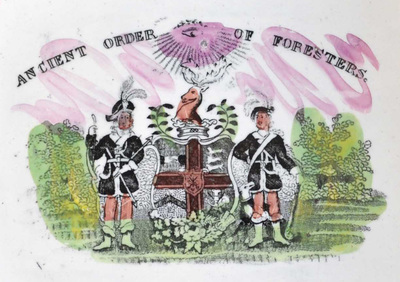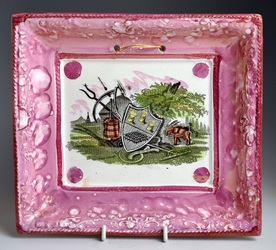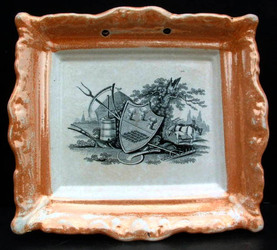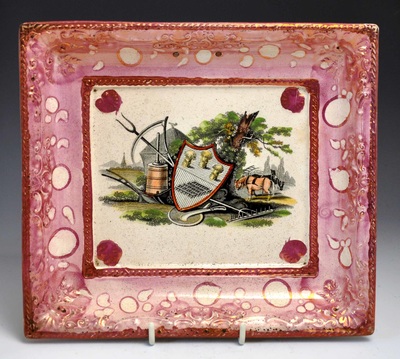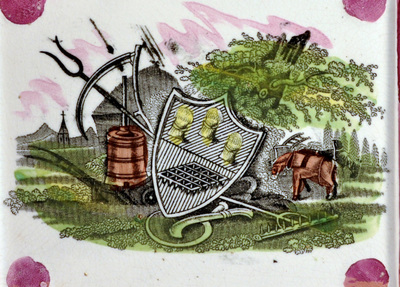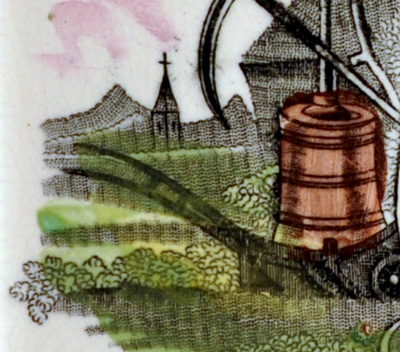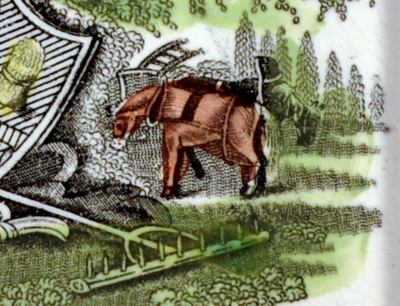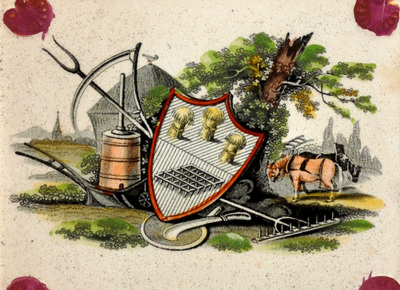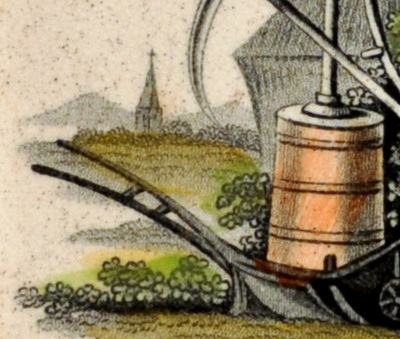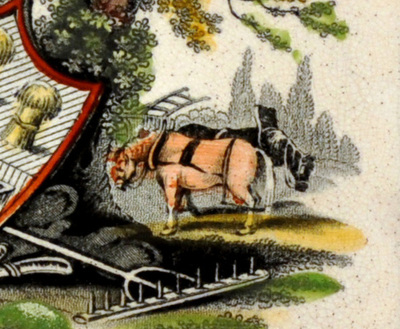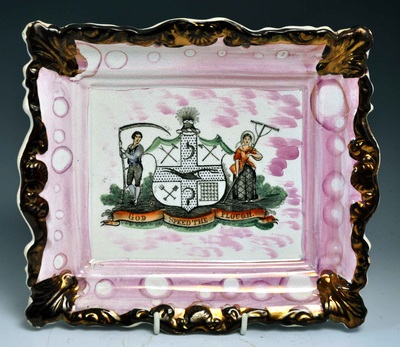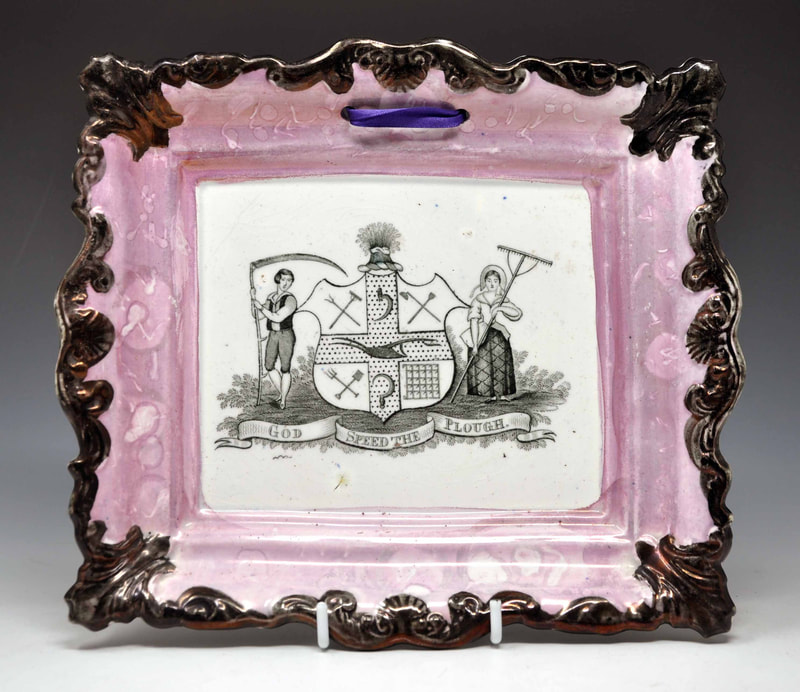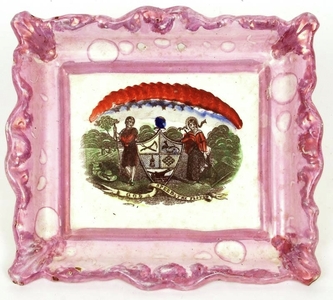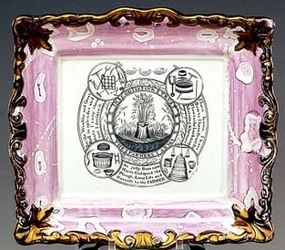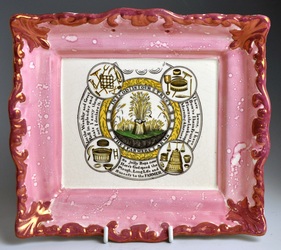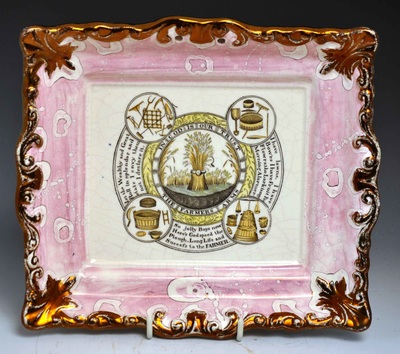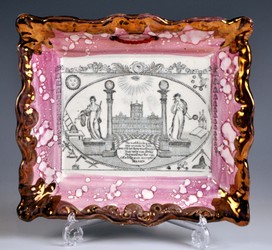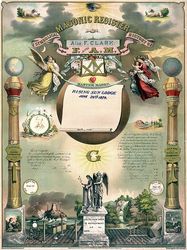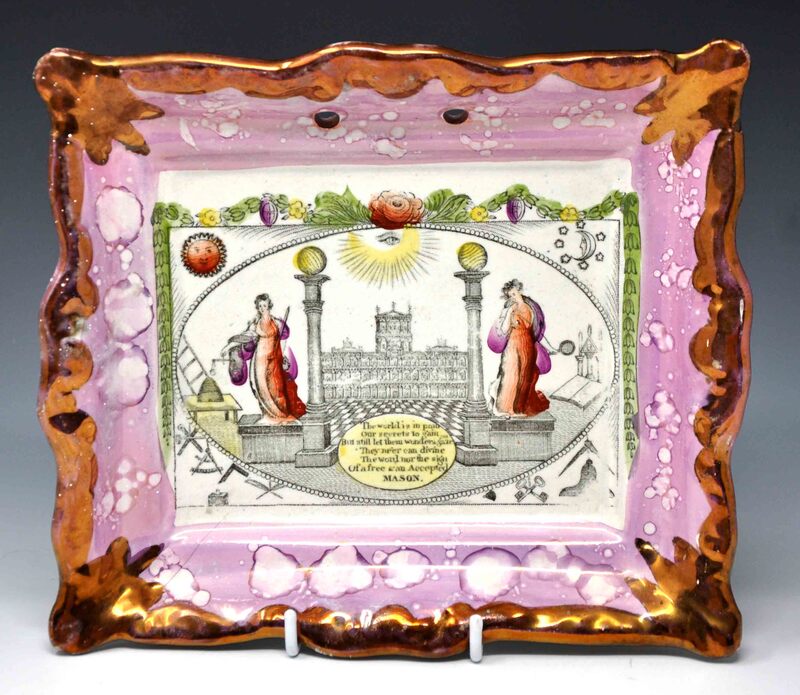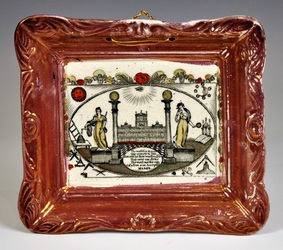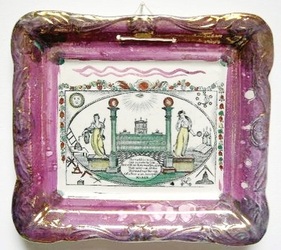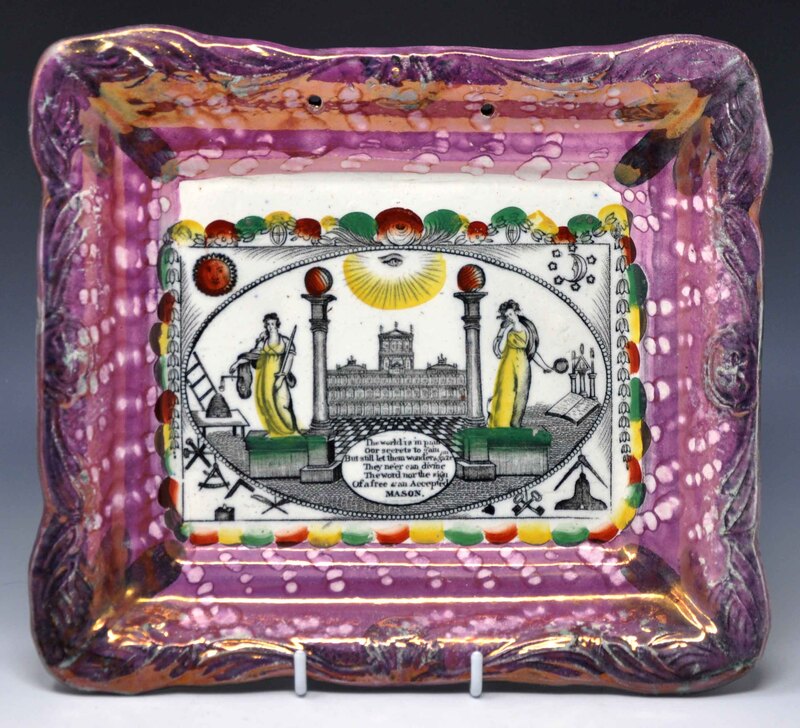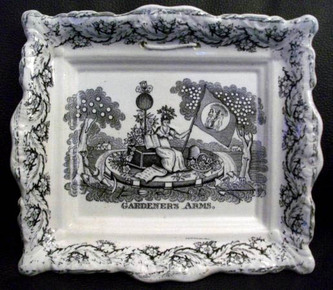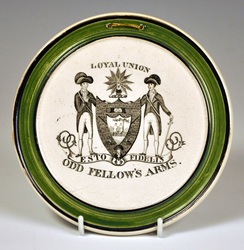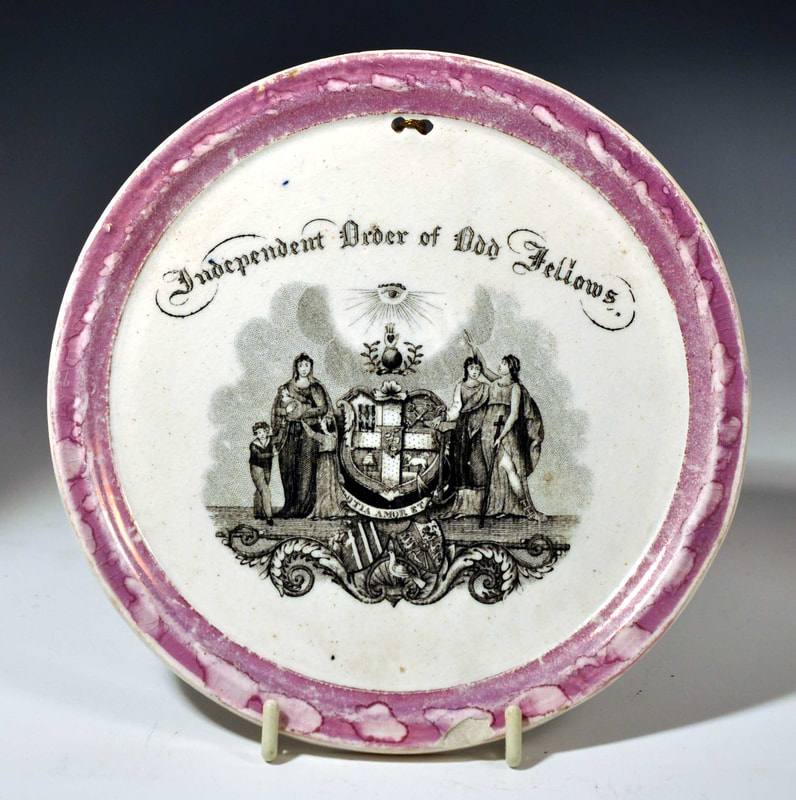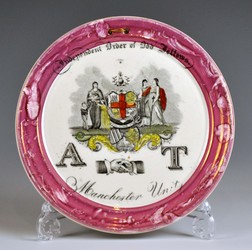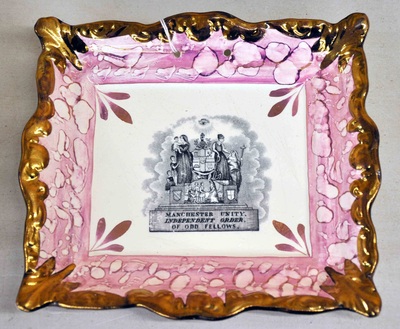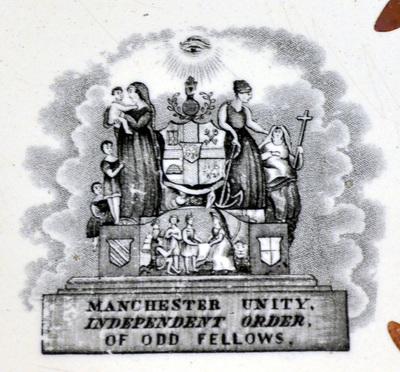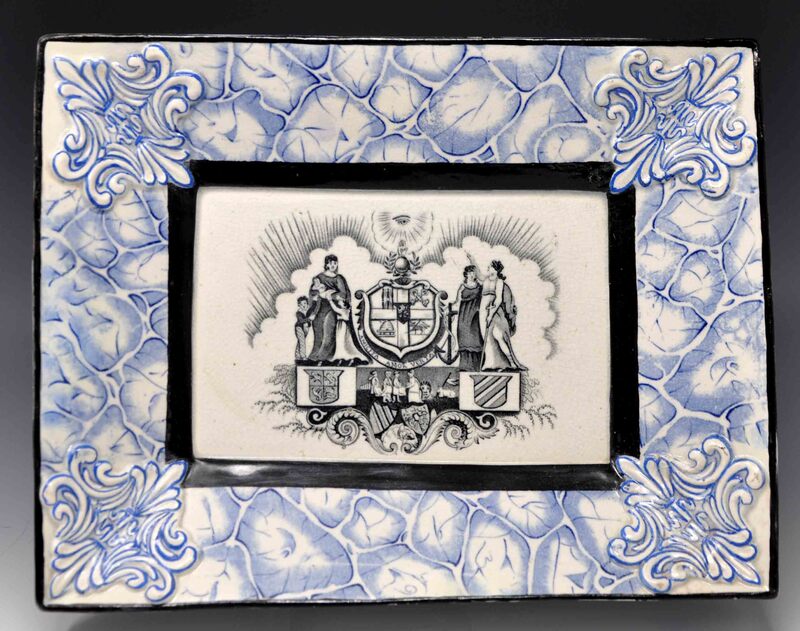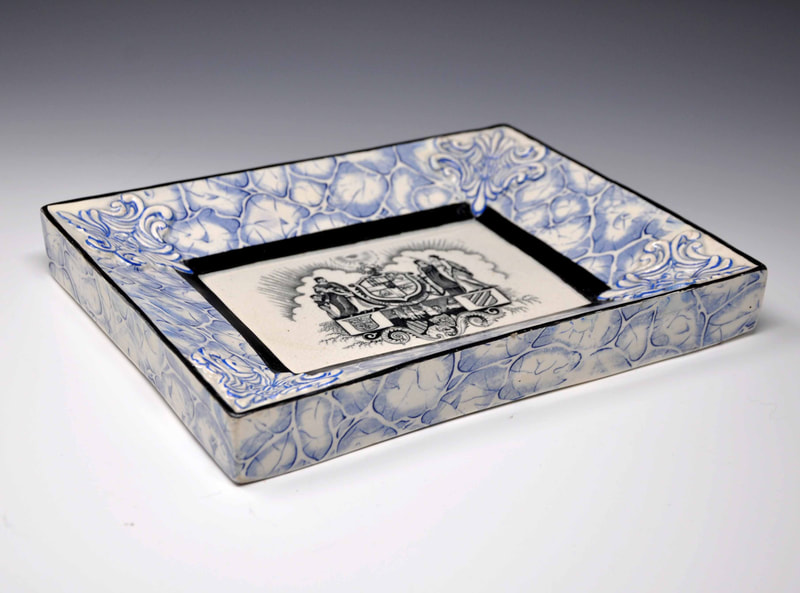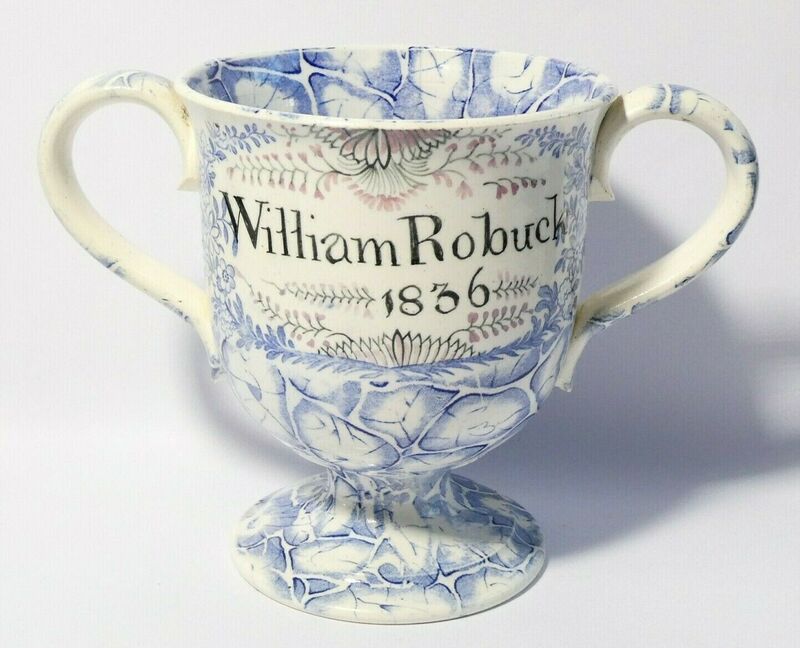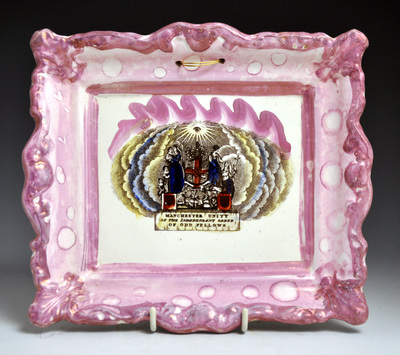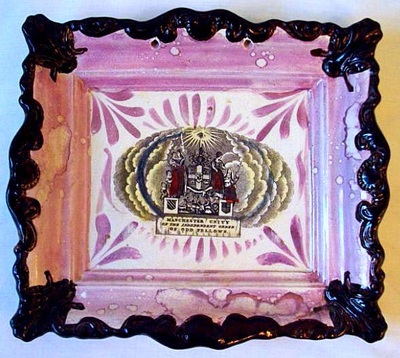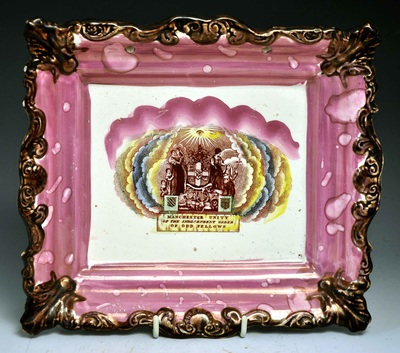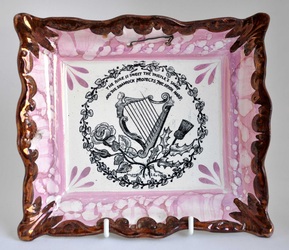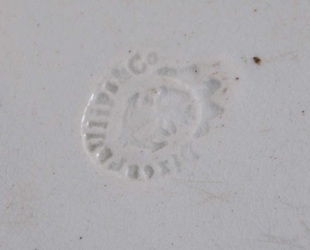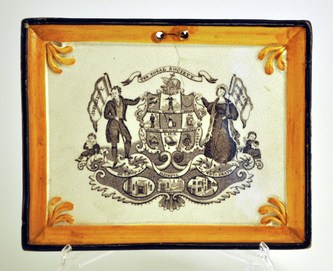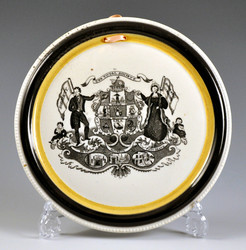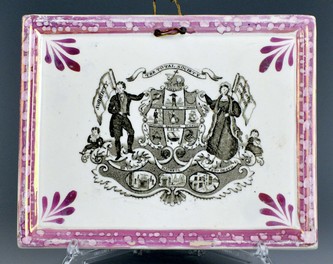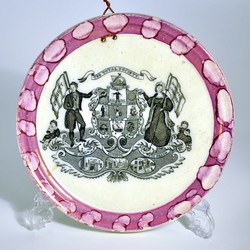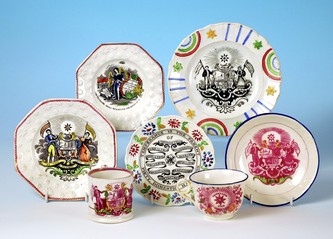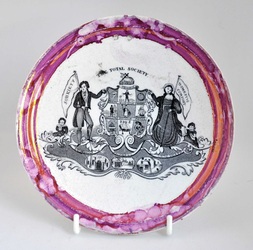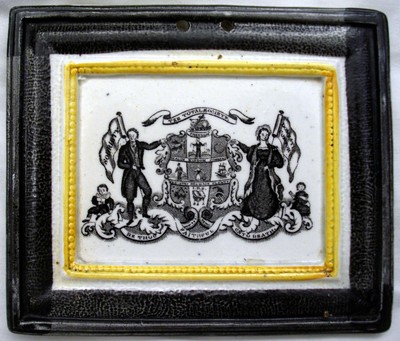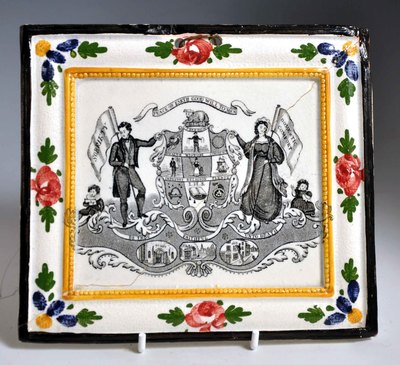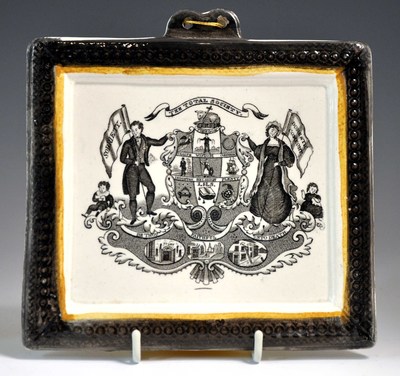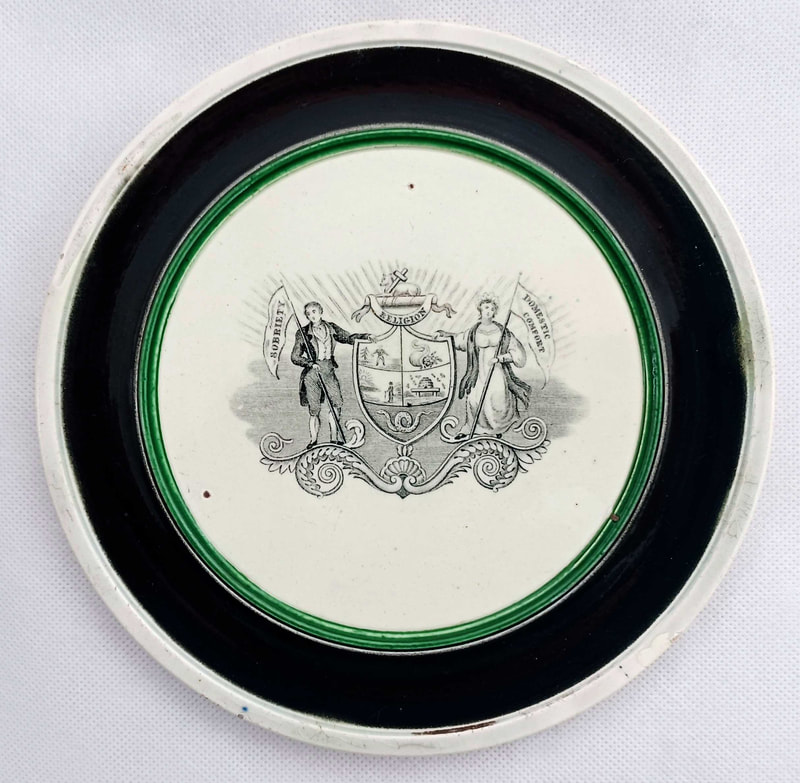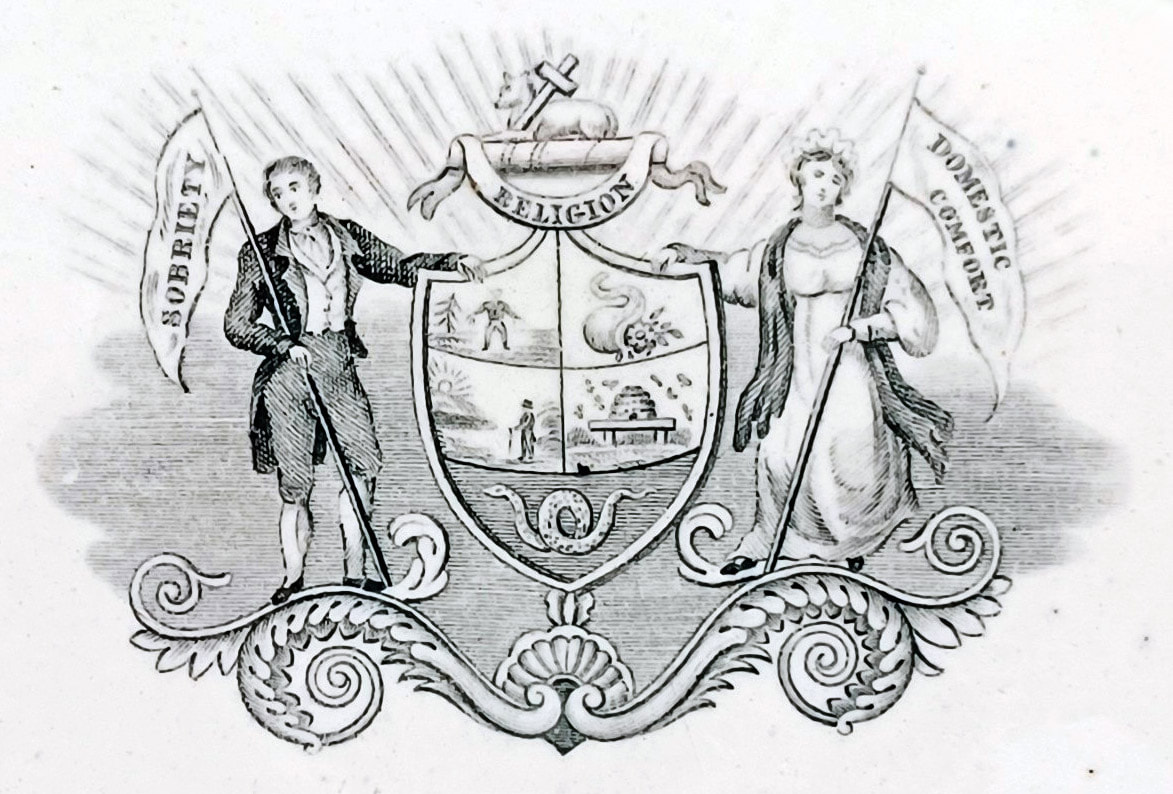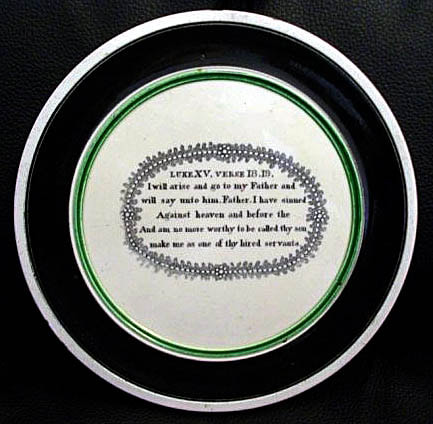Emblems and armorials
See the Mariner's arms/compass page for maritime emblems and armorials.
Contents of this page:
Ancient Order of Foresters (Dixon, Moore, Scott)
Farmer's Arms (Scott, Moore, Adams)
Freemasonry (Dixon, Carr)
Gardener's Arms
Independent Order of Odd Fellows
Irish Harp
Tee Total Society
Contents of this page:
Ancient Order of Foresters (Dixon, Moore, Scott)
Farmer's Arms (Scott, Moore, Adams)
Freemasonry (Dixon, Carr)
Gardener's Arms
Independent Order of Odd Fellows
Irish Harp
Tee Total Society
Ancient Order of Foresters
The above circular plaque from the 1830s is unmarked, but of a form associated with C, C & Co at North Shields. It is incredibly rare and the only item with this transfer I have recorded.
The top left plaque below is from the Garrison Pottery (Dixon's). The top right plaque below, attributed to Moore's Wear Pottery, has the Foresters' motto 'Unitas Benevolentia et Concordia' (Unity, Benevolence and Concord). The bottom left plaque is attributed to Scott's.
The top left plaque below is from the Garrison Pottery (Dixon's). The top right plaque below, attributed to Moore's Wear Pottery, has the Foresters' motto 'Unitas Benevolentia et Concordia' (Unity, Benevolence and Concord). The bottom left plaque is attributed to Scott's.
Said to be 'descended from 'Friendly Societies of Thirteenth Century England, in fact Foresters are mentioned by name in King John's "Magna Carta" in 1219. Membership originally was gained by combat, first with quarterstaffs, then swords and finally with cudgels, the latter abandoned hundreds of years agoriendly Societies of Thirteenth Century England, in fact Foresters are mentioned by name in King John's "Magna Carta" in 1219. Membership originally was gained by combat, first with quarterstaffs, then swords and finally with cudgels, the latter abandoned hundreds of years ago' (Wikipedia).
Henrywood writes that the society was founded in 1834 from the earlier 'Royal Foresters'. Today, Foresters invests heavily in community causes, and provides insurance services.
http://en.wikipedia.org/wiki/Independent_Order_of_Foresters
Henrywood writes that the society was founded in 1834 from the earlier 'Royal Foresters'. Today, Foresters invests heavily in community causes, and provides insurance services.
http://en.wikipedia.org/wiki/Independent_Order_of_Foresters
Farmer's Arms
There are two very similar versions of this transfer used by Scott's. The left above is more common (details shown in the first row below). The transfer on the above right plaque (details shown in the second row below) also appears rarely on later orange plaques (above centre).
Two further farming armorials are shown below. The first two (left and centre) are attributed to Newbottle, and the third (right) to Moore's.
The three plaques below, although unmarked, are attributed to Adams Pottery in Staffordshire, and were made in the first half of the 20th century. Read more here.
Freemasonry
Top: two Garrison pink lustre plaques with the impressed mark 'Dixon Co' (c1850s). Below: three plaques of a form attributed to John Carr's Low Lights Pottery (c1865). Henrywood writes that the transfer contains 'various Masonic symbols such as the sun, moon and stars, keys, and square and compasses, along with the figure of Justice, a hive representing industry, and a book emblematic of learning'. The verse is as follows:
The world is in pain
Our secrets to gain
But still let them wonder & gaze on
They ne'er can divine
The word nor the sign
Of a free & an Accepted
MASON.
The above centre image shows a certificate for the Masonic Register (1876).
http://en.wikipedia.org/wiki/Freemasonry
The world is in pain
Our secrets to gain
But still let them wonder & gaze on
They ne'er can divine
The word nor the sign
Of a free & an Accepted
MASON.
The above centre image shows a certificate for the Masonic Register (1876).
http://en.wikipedia.org/wiki/Freemasonry
Gardener's Arms
An unusual monochrome plaque that pairs with the Mariner's Arms.
Independent Order of Odd Fellows
The top left plaque with an unusual green border, of an earlier date, c1830. The text reads: 'LOYAL UNION', 'ESTO FIDELIS' (be faithful), 'ODD FELLOW'S ARMS.'. The top centre plaque, of a form associated with C, C & Co, titled 'Independent Order of Odd Fellows.'. The top right plaque has hands clasped in a handshake, and the letters 'A' and 'T'. Beneath them the words 'Manchester Unity'. It is hard to see, but there's a printed signature for the engraver 'M Ryles Sc' [Sculpt] under the central transfer and the word 'Hylton', so this plaque is attributed to Dawson (read more here). The bottom left plaque is from the Garrison Pottery (Dixon's) and dates c1850.
The unusual very heavy plaque below has a marbled blue background found on an item with a believed Yorkshire inscription from the 1830s.
The unusual very heavy plaque below has a marbled blue background found on an item with a believed Yorkshire inscription from the 1830s.
The three rectangular plaques below are later, c1850s (left) and c1860s (centre and right), and attributed to Moore's Wear Pottery. The text reads: 'MANCHESTER UNITY OF THE INDEPENDENT ORDER OF ODD FELLOWS'.
According to Wikipedia:
In 1810, members of the Oddfellows in Manchester area became dissatisfied with the way the Grand United Order was being run and formed an independent Order with the title 'Manchester Unity'. This organisation is now referred to as "The Independent Order of Oddfellows (Manchester Unity)", or more simply, "The Manchester Unity Order of Odd Fellows" (MUOOF).
According to Manchester Unity literature: "With their improved organisation and rules, they encouraged many other lodges across the country to leave the old Grand United Order and join the Independent Order under the 'Manchester Compliance".
http://en.wikipedia.org/wiki/Manchester_Unity_of_Odd_Fellows#The_Independent_Order_-_Manchester_Unity
In 1810, members of the Oddfellows in Manchester area became dissatisfied with the way the Grand United Order was being run and formed an independent Order with the title 'Manchester Unity'. This organisation is now referred to as "The Independent Order of Oddfellows (Manchester Unity)", or more simply, "The Manchester Unity Order of Odd Fellows" (MUOOF).
According to Manchester Unity literature: "With their improved organisation and rules, they encouraged many other lodges across the country to leave the old Grand United Order and join the Independent Order under the 'Manchester Compliance".
http://en.wikipedia.org/wiki/Manchester_Unity_of_Odd_Fellows#The_Independent_Order_-_Manchester_Unity
The Irish Harp
THE ROSE IS SWEET THE THISTLE'S SHARP
AND THE SHAMROCK PROTECTS THE IRISH HARP.
AND THE SHAMROCK PROTECTS THE IRISH HARP.
Tee Total Society
Variations of this transfer are found on many plaques: black and yellow circular and rectangular, and pink lustre, circular and rectangular. The title reads 'TEE TOTAL SOCIETY.'. Two figures carry flags with the words 'SOBRIETY.' (the man on the left) and 'DOMESTIC COMFORT.' (the woman on the right). The shield in the centre shows the benefits of sobriety: health, wisdom, commerce, industry, religion, plenty. Below it is the motto 'BE THOU FAITHFUL UNTO DEATH.'. The top three plaques are attributed to Dixon, Austin & Co, the row below to
C, C & Co, and the bottom row to Sheriff Hill. The centre image shows a selection of temperance-related wares.
http://en.wikipedia.org/wiki/Teetotalism
To read more about the different Tee Total Society transfers, click here.
C, C & Co, and the bottom row to Sheriff Hill. The centre image shows a selection of temperance-related wares.
http://en.wikipedia.org/wiki/Teetotalism
To read more about the different Tee Total Society transfers, click here.
Finally, a very rare plaque with green and black border, from an unidentified pottery, and another similar with a verse from the 'prodigal son'.
